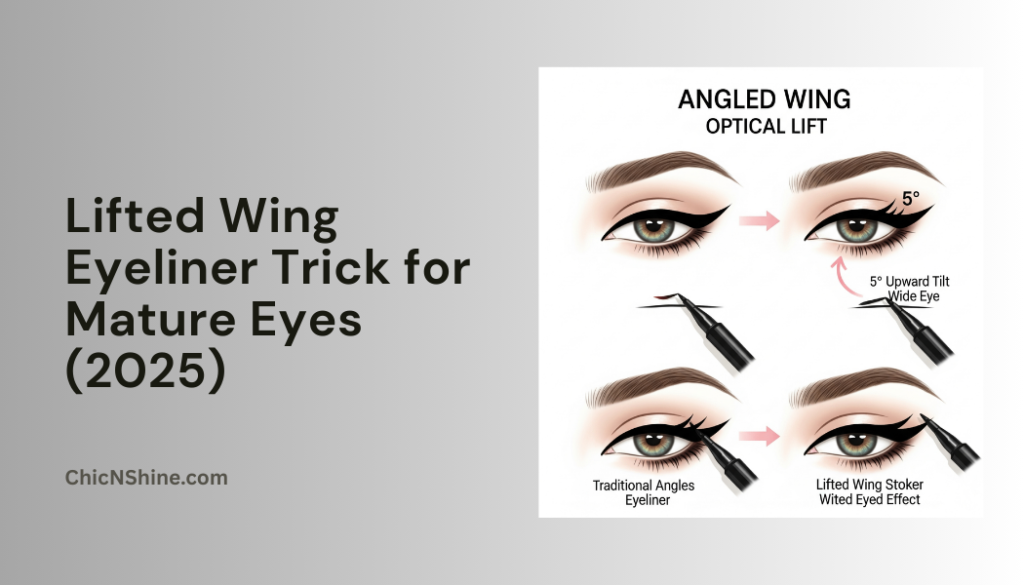At fifty-two, I found myself staring at my reflection in frustration, trying to recreate the same eyeliner look I’d worn for decades. My once-defined eyelids had developed a subtle hood, and my favorite winged liner technique was disappearing into the fold of my skin. That’s when I realized I needed to learn how to apply eyeliner with hooded mature lids instead of fighting against the natural changes in my eye shape.
After months of trial and error, consultations with professional makeup artists, and countless YouTube tutorials, I discovered what I now call the “Lifted Wing” technique. This revolutionary approach doesn’t just work with hooded mature eyes—it enhances them, creating the illusion of lifted, more youthful-looking eyes. The transformation was so dramatic that friends began asking about my “eye lift,” when all I had changed was my eyeliner application method.
The journey to mastering this technique taught me that aging gracefully doesn’t mean abandoning the makeup looks I love. Instead, it means adapting them to work with my evolving features. Understanding how to apply eyeliner with hooded mature lids opened up a whole new world of possibilities for eye makeup that I thought I’d lost forever.
Understanding the Unique Challenges of Hooded Mature Eyes
When I first started researching how to apply eyeliner with hooded mature lids, I was surprised to learn how common this eye shape is. As we age, the skin around our eyes loses elasticity and can begin to droop slightly, creating what makeup artists call a “hooded” appearance. This isn’t necessarily a dramatic change—often it’s so subtle that we don’t even notice it happening until our usual makeup techniques stop working effectively.
The primary challenge with hooded mature eyes is that traditional eyeliner application methods often result in the liner being hidden when the eyes are open. I spent years wondering why my carefully applied winged liner would seem to disappear, only to discover that it was being concealed by the natural fold of my eyelid. This realization was both frustrating and liberating, as it meant the problem wasn’t my technique—it was my approach.
Additionally, hooded mature eyes often have less visible lid space, which means that bold, thick liner applications can make the eyes appear smaller rather than larger. The skin texture may also be different, with fine lines or slightly less taut surfaces that can make liner application more challenging. Understanding these unique characteristics is crucial for developing effective application techniques that work with, rather than against, the natural aging process.
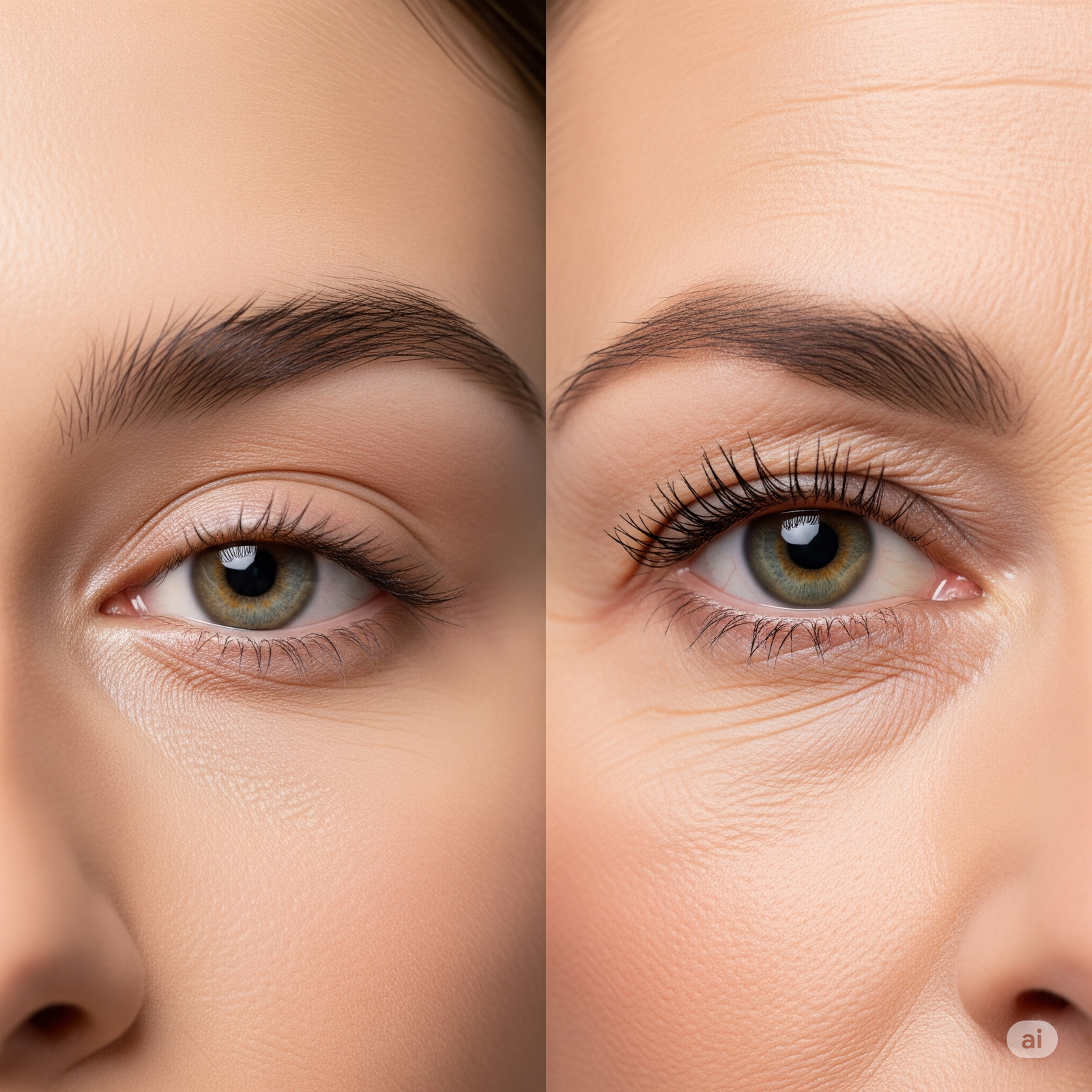
The Science Behind the ‘Lifted Wing’ Technique
The ‘Lifted Wing’ technique I developed specifically addresses the challenges of how to apply eyeliner with hooded mature lids by working with the eye’s natural anatomy rather than against it. Traditional winged liner extends horizontally from the outer corner of the eye, but with hooded mature lids, this approach often gets lost in the fold. My technique instead focuses on creating a vertical lift that remains visible regardless of the eye’s position.
The key principle behind this method is understanding the eye’s movement patterns and how the skin folds when the eye is open versus closed. When applying liner to hooded mature eyes, I’ve learned to work with the eye in its natural, relaxed state rather than stretching or manipulating the lid. This ensures that the liner appears correctly positioned when the eye is in its normal position, rather than only looking good when the eye is artificially stretched.
The ‘Lifted Wing’ technique also incorporates color theory and light reflection principles to create the illusion of lifted, more prominent eyes. By using specific shades and application angles, this method can make hooded mature eyes appear more defined and youthful. The technique leverages the natural contours of the eye socket to create shadows and highlights that enhance the eye’s natural shape rather than fighting against it.
Step-by-Step Application: The ‘Lifted Wing’ Method
Learning how to apply eyeliner with hooded mature lids using the ‘Lifted Wing’ technique requires patience and practice, but once mastered, it becomes as natural as any other makeup routine. I begin by preparing the eye area with a good eyeshadow primer, paying special attention to the areas where the liner will be applied. This step is crucial for mature skin, as it helps the liner adhere better and prevents smudging throughout the day.
The first step of the actual application involves creating what I call the “anchor point” at the outer corner of the eye. Instead of starting with the traditional wing shape, I begin by drawing a small dot approximately two millimeters above the outer corner of the eye, positioning it so that it remains visible when the eye is open in its natural state. This anchor point serves as the foundation for the entire look and ensures that the wing will be properly positioned regardless of how the eyelid folds.
From the anchor point, I create the wing by drawing a line that angles upward and outward, following the natural curve of the lower lash line as it would extend if continued. This creates a lifting effect that counteracts the downward pull of hooded mature lids. The wing should be relatively thin and precise, as thick wings can overwhelm mature eyes and make them appear smaller. I then connect this wing to the upper lash line, creating a triangle shape that I fill in completely.
The next crucial step involves applying liner to the upper lash line itself. With hooded mature eyes, I’ve found that a slightly thicker line works better than the thin applications that work well on younger eyes. I start from the inner corner and work outward, gradually increasing the thickness as I approach the outer corner where it connects to the wing. This graduated thickness helps create the illusion of fuller, more prominent eyes while maintaining a natural appearance.
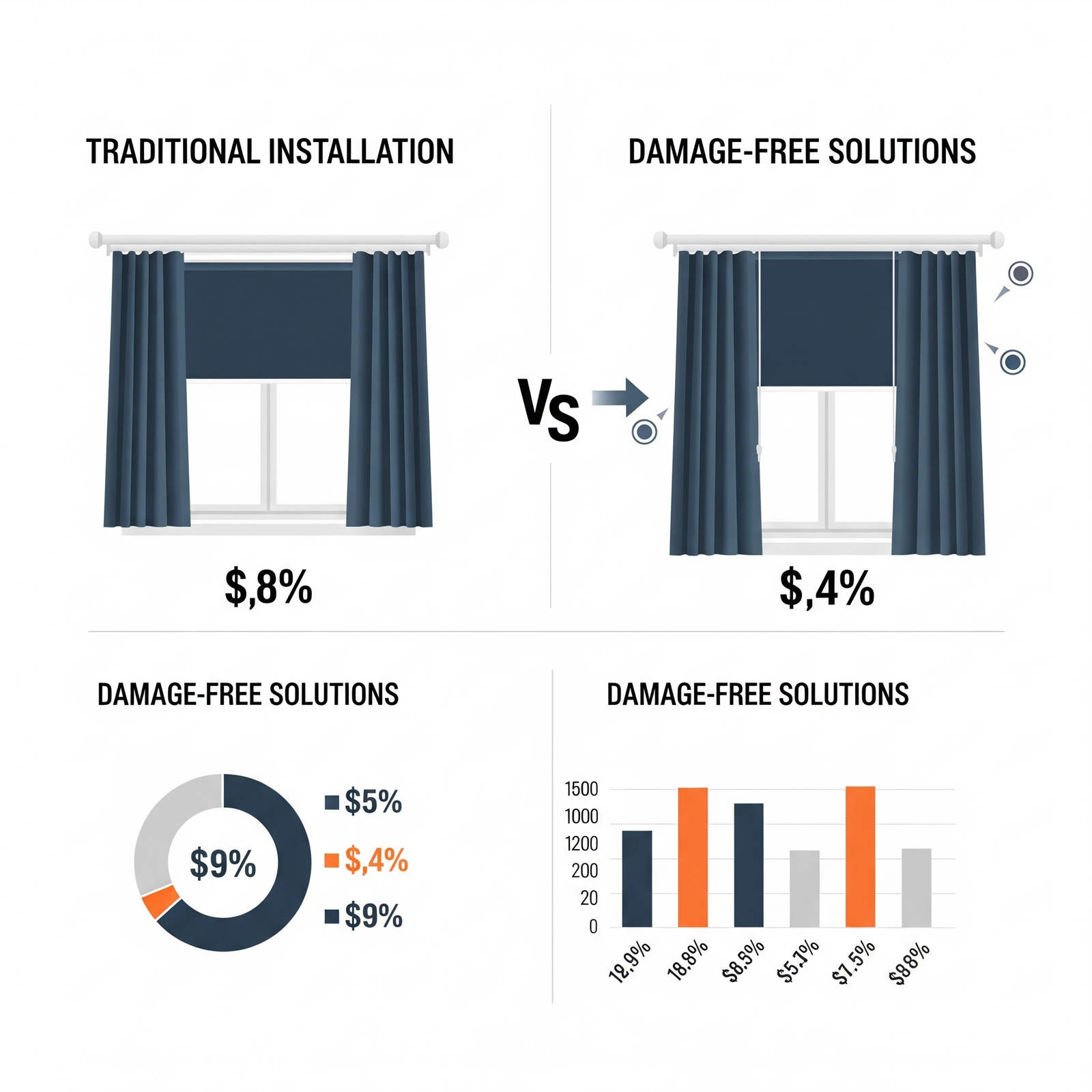
Tool Selection and Product Recommendations
The success of learning how to apply eyeliner with hooded mature lids depends heavily on choosing the right tools and products. Through extensive testing, I’ve discovered that certain types of eyeliners work significantly better than others for this specific eye shape and skin type. The ideal liner for hooded mature eyes should be long-wearing, precise, and forgiving enough to allow for adjustments during application.
I’ve found that gel eyeliners applied with a fine brush offer the best combination of precision and blendability for the ‘Lifted Wing’ technique. The gel formula allows for smooth application without tugging on delicate mature skin, while the brush provides the control needed for creating precise lines and wings. Liquid liners can work well too, but they require more skill and don’t allow for easy corrections if mistakes are made during application.
The choice of brush is equally important when mastering how to apply eyeliner with hooded mature lids. I prefer angled brushes with synthetic bristles that maintain their shape well and allow for precise control. The brush should be small enough to create fine lines but sturdy sufficient to handle the slightly thicker applications that work best on mature eyes. A good quality brush will make the difference between a professional-looking result and a messy, uneven application.
Color selection also plays a crucial role in the effectiveness of the ‘Lifted Wing’ technique. While black liner can be dramatic and beautiful, I’ve found that softer colors like dark brown, charcoal, or even deep navy can be more flattering on mature eyes. These colors are defined without being harsh, and they complement the natural changes in skin tone that occur with aging. For special occasions, I sometimes use a thin line of a darker color close to the lash line with a slightly lighter shade for the wing itself.
Amazon Suggestion: Professional Gel Eyeliner Kit – Includes multiple shades and precision brushes ideal for mature eye application.
Adapting the Technique for Different Eye Shapes
While the basic principles of how to apply eyeliner with hooded mature lids remain consistent, I’ve learned that the ‘Lifted Wing’ technique needs to be adapted based on individual eye shapes and the degree of hooding present. Deep-set hooded eyes require different considerations than prominent hooded eyes, and the technique must be modified accordingly to achieve the most flattering results.
For deep-set, hooded, mature eyes, I’ve found that the wing needs to be positioned slightly higher and more dramatically angled to remain visible. The challenge with deep-set eyes is that the natural shadow of the brow bone can obscure subtle liner applications, so the technique requires more contrast and definition. I often recommend using a slightly lighter shade of eyeshadow on the mobile lid to create a better backdrop for the liner application.
Prominent hooded mature eyes present different challenges, as the eye protrudes more from the socket, making the hooding more noticeable. For this eye shape, I focus on creating a more subtle wing that doesn’t compete with the eye’s natural prominence. The key is to enhance the eye’s natural shape rather than trying to dramatically alter it. I also pay special attention to the inner corner of the eye, sometimes adding a small amount of highlighter to create balance with the outer wing.
Close-set, hooded, mature eyes benefit from modifications that create the illusion of wider spacing between the eyes. I achieve this by starting the liner application slightly away from the inner corner and extending the wing more dramatically outward. This technique helps balance the proportions of the face while still addressing the challenges of hooded lids. Conversely, wide-set, hooded, mature eyes benefit from liner that extends slightly closer to the inner corner and a more vertical wing angle.
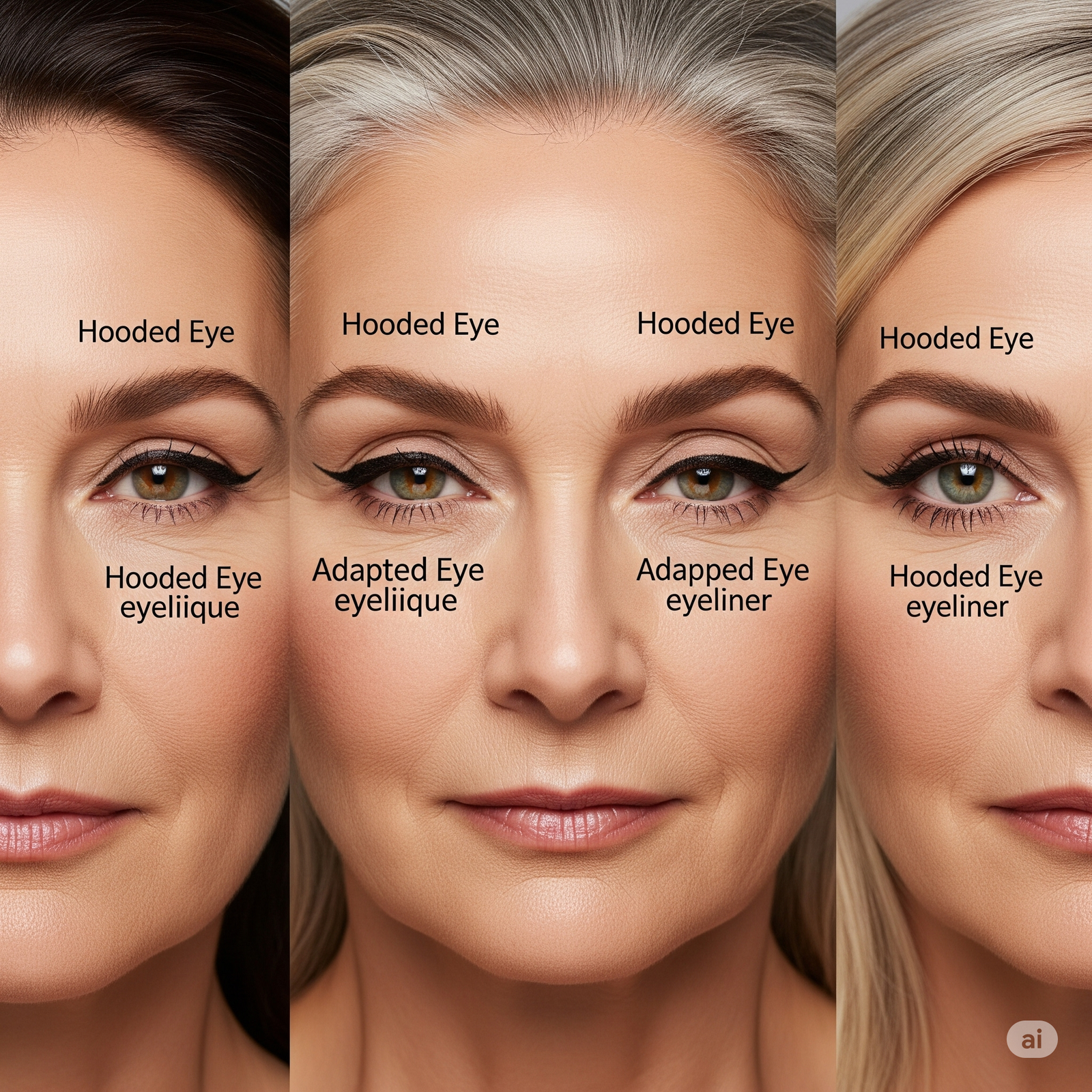
Advanced Techniques and Refinements
As I’ve become more skilled at how to apply eyeliner with hooded mature lids, I’ve developed several advanced techniques that can further enhance the ‘Lifted Wing’ approach. These refinements address specific challenges that arise with different lighting conditions, occasions, and personal preferences, allowing for a more customized application that works perfectly for individual needs.
One advanced technique involves creating a “double wing” effect, where I apply a thin line of highlighting concealer or light eyeshadow just above the main wing. This creates the illusion of even more lift and can make the eyes appear larger and more prominent. The highlighting should be subtle and well-blended, appearing as a natural reflection rather than an obvious makeup application.
Another refinement I’ve mastered is the “graduated wing” technique, where the wing starts thin at the outer corner and gradually increases in thickness as it extends outward. This creates a more natural-looking lift that doesn’t appear harsh or artificial. The technique requires careful blending and precision, but the results are worth the extra effort, especially for professional or formal occasions.
For special events or when I want a more dramatic look, I’ve developed a technique that incorporates a thin line of metallic or shimmer liner along the upper edge of the wing. This catches the light and creates an even more lifting effect while adding glamour to the overall look. The metallic accent should be applied with a very fine brush and should complement rather than compete with the main liner application.
Amazon Suggestion: Shimmer Eyeliner Set – Metallic accents perfect for enhancing the ‘Lifted Wing’ technique for special occasions
Common Mistakes and How to Avoid Them
Through my journey of learning how to apply eyeliner with hooded mature lids, I’ve made virtually every mistake possible and learned valuable lessons from each one. Understanding these common pitfalls can help others avoid the frustration I experienced and achieve better results more quickly.
One of the most frequent mistakes I see is applying liner with the eyes closed or stretched, which results in a completely different look when the eyes return to their natural position. I learned to always check my work with my eyes open and in their relaxed state, making adjustments as needed. This means the application process takes longer, but the results are infinitely better.
Another common error is making the wing too thick or too horizontal. With hooded mature eyes, thick wings can overwhelm the eye and make it appear smaller. I’ve learned that a thin, precisely placed wing is always more effective than a bold, heavy application. Similarly, horizontal wings often disappear into the fold of hooded lids, while vertical or diagonal wings remain visible and create the desired lifting effect.
Many people also make the mistake of using the wrong pressure when applying liner to mature skin. Too much pressure can cause the liner to skip or drag, while too little pressure results in patchy, uneven application. I’ve found that the key is to use steady, consistent pressure while allowing the product to do most of the work. This is where having the right tools and products becomes crucial for success.
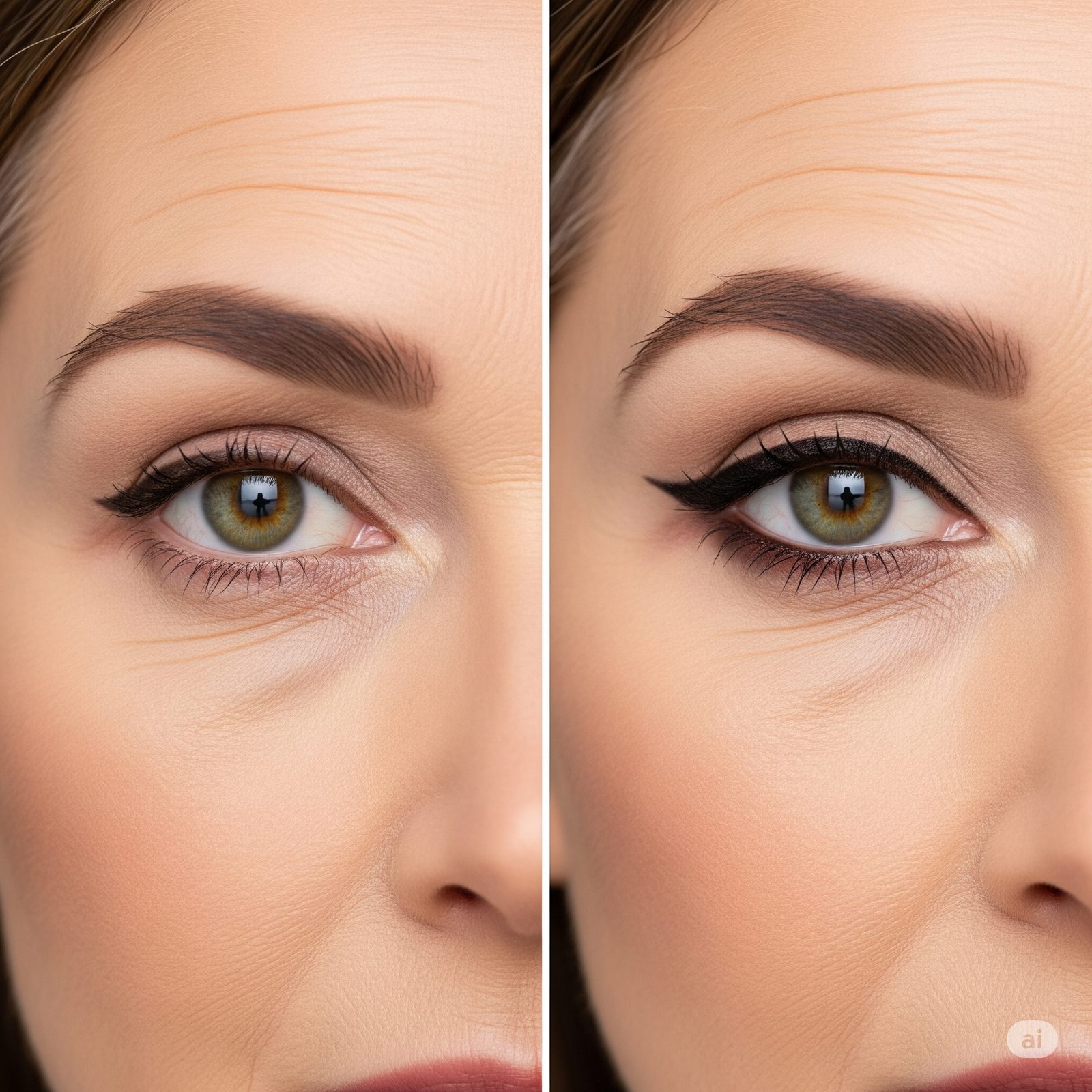
Maintenance and Touch-Up Strategies
Learning how to apply eyeliner with hooded mature lids is only half the battle—maintaining the look throughout the day requires specific strategies that account for the unique challenges of mature skin and hooded eye shapes. I’ve developed a comprehensive approach to touch-ups and maintenance that keeps my liner looking fresh from morning to night.
The foundation of good liner maintenance begins with proper preparation and product selection. I always use an eyeshadow primer specifically designed for mature skin, which helps the liner adhere better and prevents the smudging that can occur when the hooded skin comes into contact with the liner throughout the day. Setting the liner with a matching eyeshadow powder also helps extend its wear time significantly.
Throughout the day, I’ve learned to resist the urge to rub or touch my eyes, as this can disturb the liner application and cause smudging. Instead, I carry a small precision brush and a compact mirror for quick touch-ups when needed. The key is to address any smudging immediately rather than letting it build up over time. I gently blend away any imperfections and reapply liner only where necessary.
For longer days or special events, I’ve developed a technique for strategic reapplication that doesn’t require completely redoing the entire look. I focus on refreshing the wing area, which tends to fade first due to the natural oils in the skin and the movement of the eyelid. A quick touch-up of the wing’s tip and a light dusting of setting powder can restore the fresh appearance without requiring a complete reapplication.
Coordinating with Other Eye Makeup
The ‘Lifted Wing’ technique for how to apply eyeliner with hooded mature lids works best when coordinated with other eye makeup elements that complement and enhance the overall look. I’ve learned that the liner should be part of a cohesive eye makeup strategy rather than a standalone element, and this requires understanding how different products interact with hooded mature eyes.
Eyeshadow selection and application become crucial when working with hooded mature lids. I’ve found that lighter, neutral shades work best on the mobile lid, as they help create the illusion of more space and provide a good backdrop for the liner application. Darker shades should be used sparingly and placed strategically in the outer corner to enhance the lifting effect of the wing.
Mascara application also requires special consideration with hooded mature eyes. I’ve learned to focus on lengthening rather than volumizing formulas, as thick, heavy lashes can compete with the liner and make the eyes appear smaller. I pay particular attention to curling the lashes before applying mascara, as this helps open up the eye area and makes the liner more visible.
The coordination of these elements creates a harmonious look that enhances the natural beauty of mature eyes rather than trying to disguise their characteristics. I’ve found that when all elements work together, the result is sophisticated and age-appropriate while still being modern and attractive. The key is understanding that each element should support the others rather than competing for attention.

Troubleshooting Specific Challenges
Even with proper technique and quality products, learning how to apply eyeliner with hooded mature lids can present unique challenges that require specific solutions. I’ve encountered virtually every possible problem and developed strategies for addressing them effectively without having to start over completely.
One of the most common issues is a line that appears uneven or crooked when the eyes are open, despite looking perfect when applied with the eyes closed. I’ve learned to constantly check my work with my eyes open and make micro-adjustments as needed. This often means redrawing small sections of the line multiple times, but the final result is worth the extra effort. I’ve also developed a technique for using the natural fold of the lid as a guide for wing placement.
Smudging is another frequent challenge, particularly in the outer corner where the wing meets the mobile lid. I’ve found that this usually occurs due to excess oils on the skin or an inadequate setting of the liner. My solution involves thorough cleansing and priming of the area before application, followed by setting with powder. For persistent smudging issues, I sometimes use a long-wearing, waterproof formula specifically in problem areas.
Color payoff can be inconsistent on mature skin, with some areas appearing darker or lighter than intended. I’ve learned to build up the color gradually rather than trying to achieve full intensity in one application. This approach allows for better control and more even results. I also pay attention to the natural texture of the skin and adjust my application technique accordingly, using lighter pressure over fine lines and more precise movements around textured areas.
The Psychology of Makeup and Aging
Learning how to apply eyeliner with hooded mature lids has taught me that makeup techniques are about more than just appearance—they’re about confidence, self-expression, and adapting to life’s changes with grace. The process of mastering the ‘Lifted Wing’ technique has been as much about accepting my changing features as it has been about learning new skills.
Initially, I approached this challenge with frustration and resistance, viewing my hooded lids as a problem to be solved rather than a natural evolution to be embraced. This mindset made the learning process more difficult and less enjoyable. It wasn’t until I shifted my perspective to viewing these changes as opportunities for growth and creativity that I began to make real progress.
The confidence that comes from mastering a technique specifically designed for your unique features cannot be overstated. When I wear my eyeliner now, I feel like I’m enhancing my natural beauty rather than fighting against it. This shift in mindset has influenced not just my makeup routine but my entire approach to aging and self-care.
I’ve also discovered that sharing this knowledge with other women has been incredibly rewarding. There’s a community of women who face similar challenges, and helping others learn how to apply eyeliner with hooded mature lids has created connections and friendships that extend far beyond makeup. The technique has become a tool for empowerment and self-expression that transcends age barriers.
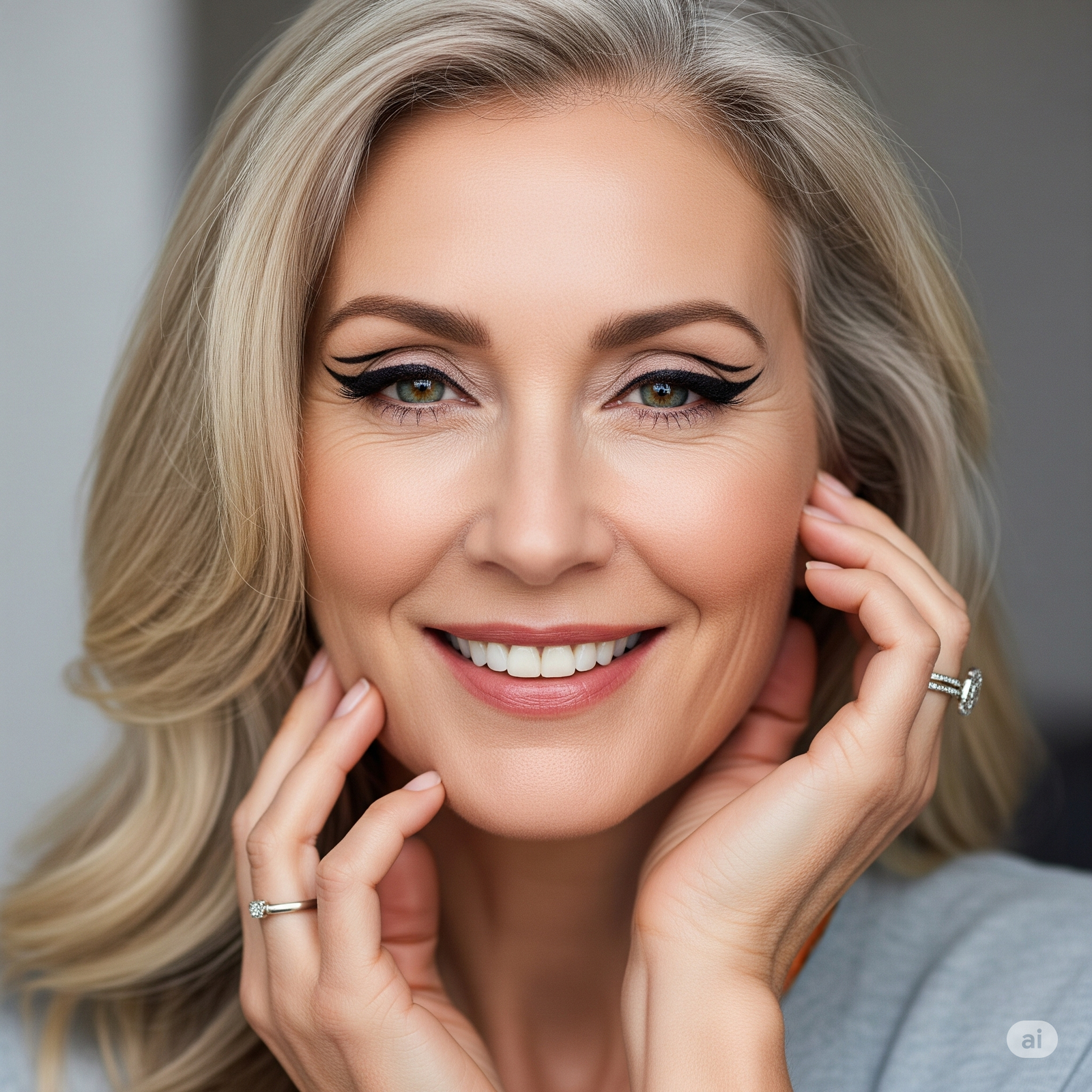
Seasonal and Occasion Adaptations
The versatility of the ‘Lifted Wing’ technique for how to apply eyeliner with hooded mature lids allows for adaptations that work for different seasons, occasions, and personal style preferences. I’ve developed variations of the basic technique that can be subtle enough for daytime wear or dramatic enough for evening events, all while maintaining the core principles that make it effective for hooded mature eyes.
For everyday wear, I use a simplified version of the technique with a thinner wing and softer color choices. This creates a definition without being overly dramatic, making it appropriate for professional settings or casual activities. The key is maintaining the lifting angle of the wing while reducing its prominence, creating a look that enhances the eyes without drawing excessive attention.
Evening or special occasion applications allow for more dramatic interpretations of the technique. I might use a bolder color, create a more prominent wing, or add metallic accents to catch the light. These variations still follow the same basic principles but are intensified to create more impact under artificial lighting or for photography.
Seasonal adaptations often involve color choices that complement the changing wardrobe and environmental factors. In summer, I might use warmer tones that complement sun-kissed skin, while winter calls for cooler, more dramatic shades that work well with the season’s fashion choices. The technique remains consistent, but the color palette shifts to maintain harmony with the overall look.
FAQs
How long does it take to master the 'Lifted Wing' technique for hooded mature lids?
In my experience, it takes about 2-3 weeks of daily practice to feel comfortable with the basic technique. However, I continued refining and perfecting my approach for several months. The key is to be patient with yourself and remember that each person's eyes are unique, so some adaptation is always necessary.
Can this technique work if I have very hooded eyes or significant drooping?
Yes, but the technique may need to be more dramatically adapted. For severely hooded eyes, I recommend positioning the wing even higher and making it more vertical. You might also need to use slightly bolder colors to ensure visibility. If you have concerns about significant drooping, consulting with a professional makeup artist can provide personalized guidance.
What's the best way to remove eyeliner from mature, sensitive skin?
I always use a gentle, oil-based makeup remover and avoid rubbing or tugging at the delicate eye area. I prefer to soak a cotton pad with remover and gently press it against the eye for a few seconds before wiping away. This method is much gentler than scrubbing and helps preserve the skin's elasticity.
